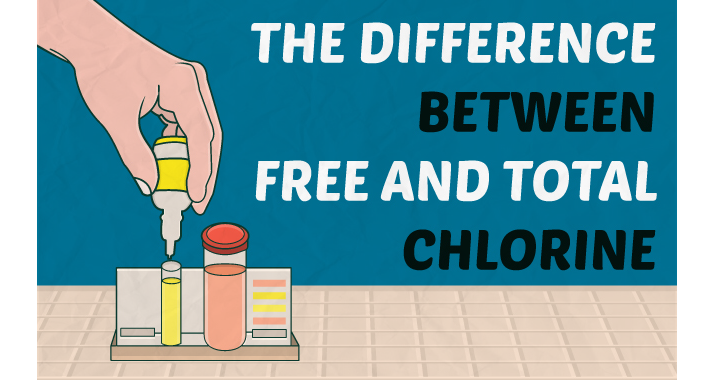Free and Total Chlorine
The Difference Between Free and Total Chlorine
The Difference Between Free and Total Chlorine
 The chlorine levels in your pool are one of the most important measurements you must keep track of all the time. After all, it’s what sanitizes your pool.
The chlorine levels in your pool are one of the most important measurements you must keep track of all the time. After all, it’s what sanitizes your pool.
There are different types of chlorine, and it confuses pool owners. What they should be testing for in their pools?
Pool experts throw around terms like “free chlorine” and “total chlorine.” This just leads to confusion. So, let’s stop and explain the differences between free and total chlorine. Because once you understand, you will then be able to better track the levels in your pool.
Three Types of Chlorine
We’re focusing on free and total chlorine today. But there are actually three types of chlorine. They are:
- Free Chlorine – This is the chlorine that you usually test for in your pool water. This chlorine is available to sanitize your pool. Your pool should have between 1 and 3 parts per million (ppm) in the water.
- Combined Chlorine – This is chlorine that’s been used up by the sanitation process of the water. While it’s still in the water, its ability to sanitize is reduced compared to free chlorine.
- Total Chlorine – This type of chlorine is the sum of both free chlorine and combined chlorine.
Breaking Down the Differences in Free and Total Chlorine
To help explain the differences, take a look at this simple formula for chlorine:
FC + CC = TC
When you add chlorine to your pool, it reacts with the water to form hypochlorous acid and hypochlorite ion. These compounds together form what we call free chlorine.
Once this chlorine begins to react with the contaminants in the water, such as nitrogen and ammonia, it becomes combined chlorine.
In this state, the chlorine isn’t as effective at sanitizing compared to free chlorine. Your goal is to make sure your pool is sanitized. You want to make sure your free chlorine levels stay in check.
For example, if your free chlorine levels and total chlorine levels are the same, then there’s no combined (or used chlorine) in your water. If your total chlorine level is higher than the free chlorine level, the difference of the two are the combined chlorine levels.
To make sure your pool is sanitized, your free chlorine should remain higher than your combined chlorine.
Time for Some Simple Pool Math
I know, you didn’t expect to have to do math when you bought your pool. But it’s critical to maintain high water quality.
These numbers will help you determine exactly how much chlorine to add for it to continue doing its job of destroying bacteria and any other contaminants in the water.
If you notice your combined chlorine levels going up, you know the time has come to rebalance the sanitizer in the water by adding extra chlorine to your pool. If the levels are low, then you may not need to do anything at all that day.
Source: Swim University – The Complete Guide for pool sanitation. The Difference Between Free and Total Chlorine.
